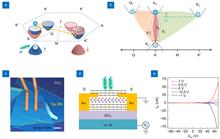 View fulltext
View fulltext
Monolayer group VI transition metal dichalcogenides (TMDs) have recently emerged as promising candidates for photonic and opto-valleytronic applications. The optoelectronic properties of these atomically-thin semiconducting crystals are strongly governed by the tightly bound electron-hole pairs such as excitons and trions (charged excitons). The anomalous spin and valley configurations at the conduction band edges in monolayer WS2 give rise to even more fascinating valley many-body complexes. Here we find that the indirect Q valley in the first Brillouin zone of monolayer WS2plays a critical role in the formation of a new excitonic state, which has not been well studied. By employing a high-quality h-BN encapsulated WS2 field-effect transistor, we are able to switch the electron concentration within K-Q valleys at conduction band edges. Consequently, a distinct emission feature could be excited at the high electron doping region. Such feature has a competing population with the K valley trion, and experiences nonlinear power-law response and lifetime dynamics under doping. Our findings open up a new avenue for the study of valley many-body physics and quantum optics in semiconducting 2D materials, as well as provide a promising way of valley manipulation for next-generation entangled photonic devices.
Flat optical elements have attracted enormous attentions and act as promising candidates for the next generation of optical components. As one of the most outstanding representatives, liquid crystal (LC) has been widely applied in flat panel display industries and inspires the wavefront modulation with the development of LC alignment techniques. However, most LC elements perform only one type of optical manipulation and are difficult to realize the multifunctionality and light integration. Here, flat multifunctional liquid crystal elements (FMLCEs), merely composed of anisotropic LC molecules with space-variant orientations, are presented for multichannel information manipulation by means of polarization, space and wavelength multiplexing. Specifically, benefiting from the unique light response with the change of the incident polarization, observation plane, and working wavelength, a series of FMLCEs are demonstrated to achieve distinct near- and far-field display functions. The proposed strategy takes full advantage of basic optical parameters as the decrypted keys to improve the information capacity and security, and we expect it to find potential applications in information encryption, optical anti-counterfeiting, virtual/augmented reality, etc.
Fluorescence imaging through the second near-infrared window (NIR-II,1000–1700 nm) allows in-depth imaging. However, current imaging systems use wide-field illumination and can only provide low-contrast 2D information, without depth resolution. Here, we systematically apply a light-sheet illumination, a time-gated detection, and a deep-learning algorithm to yield high-contrast high-resolution volumetric images. To achieve a large FoV (field of view) and minimize the scattering effect, we generate a light sheet as thin as 100.5 μm with a Rayleigh length of 8 mm to yield an axial resolution of 220 μm. To further suppress the background, we time-gate to only detect long lifetime luminescence achieving a high contrast of up to 0.45 Ιcontrast. To enhance the resolution, we develop an algorithm based on profile protrusions detection and a deep neural network and distinguish vasculature from a low-contrast area of 0.07 Ιcontrast to resolve the 100 μm small vessels. The system can rapidly scan a volume of view of 75 × 55 × 20 mm3 and collect 750 images within 6 mins. By adding a scattering-based modality to acquire the 3D surface profile of the mice skin, we reveal the whole volumetric vasculature network with clear depth resolution within more than 1 mm from the skin. High-contrast large-scale 3D animal imaging helps us expand a new dimension in NIR-II imaging.
Plasmonic vortices confining orbital angular momentums to surface have aroused wide research interest in the last decade. Recent advances of near-field microscopes have enabled the study on the spatiotemporal dynamics of plasmonic vortices, providing a better understanding of optical orbital angular momentums in the evanescent wave regime. However, these works only focused on the objective characterization of plasmonic vortex and have not achieved subjectively tailoring of its spatiotemporal dynamics for specific applications. Herein, it is demonstrated that the plasmonic vortices with the same topological charge can be endowed with distinct spatiotemporal dynamics by simply changing the coupler design. Based on a near-field scanning terahertz microscopy, the surface plasmon fields are directly obtained with ultrahigh spatiotemporal resolution, experimentally exhibiting the generation and evolution divergences during the whole lifetime of plasmonic vortices. The proposed strategy is straightforward and universal, which can be readily applied into visible or infrared frequencies, facilitating the development of plasmonic vortex related researches and applications.
3D solidification of photo-polymerisable mixtures using ultra-short laser pulses can open new directions in formation of glass-ceramics with resolution at tens-of-nanometers.
A functional beam splitter is proposed with recently realized topological antichiral edge states, which offer multi-channel utilization, crosstalk-proof performance, and robustness against defects and obstacles.














